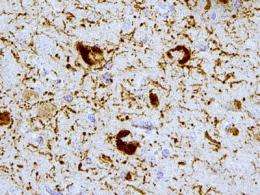Study suggests another avenue for detecting Alzheimer's disease

Researchers at the University of Pennsylvania School of Medicine have determined that a well-known chemical process called acetylation has a previously unrecognized association with one of the biological processes associated with Alzheimer's disease and related disorders. The findings were published in the latest issue of Nature Communications.
Tau is one of the primary disease proteins associated with a suite of neurodegenerative diseases. Tau proteins are expressed primarily in the central nervous system where they help with the assembly and stability of microtubules, protein structures that are the backbone of the nerve-cell communication system.
"Acetylation was only detected in diseased brain tissue from patients with Alzheimer's disease or frontotemporal degeneration, suggesting it may have a role in tau transformation linked to disease onset and progression," says senior author Virginia M.-Y. Lee, PhD, director of Penn's Center for Neurodegenerative Disease Research. "This suggests that one type of acetylation is a potential target for drug discovery and biomarker development for Alzheimer's and related tauopathies."
The researchers demonstrated that tau acetylation led to a loss of one of its major functions - to promote microtubule assembly, in addition to gaining a toxic function, pathological tau aggregation. Mass spectrometry analysis identified specific acetylation sites in the tau protein sequence that overlapped with known microtubule binding sequences, so acetylation may also play a role in faulty binding of tau to microtubules.
How normal tau becomes disengaged from microtubules to form disease-related clumps remains unknown. This study shows that acetylation is most likely another chemical modification implicated in neurodegenerative disorders to be explored as a potential way to detect and fight brain disease.
According to Lee, the next steps to follow up on this discovery are to pursue basic research into the mechanisms underlying this pathological acetylation of tau and its role in neurodegeneration in Alzheimer's disease and related tauopathies. In addition, she noted that "Our highest priority will be to find ways to translate these findings into better diagnostics and therapeutics for patients with Alzheimer's disease or frontotemporal degeneration."
















